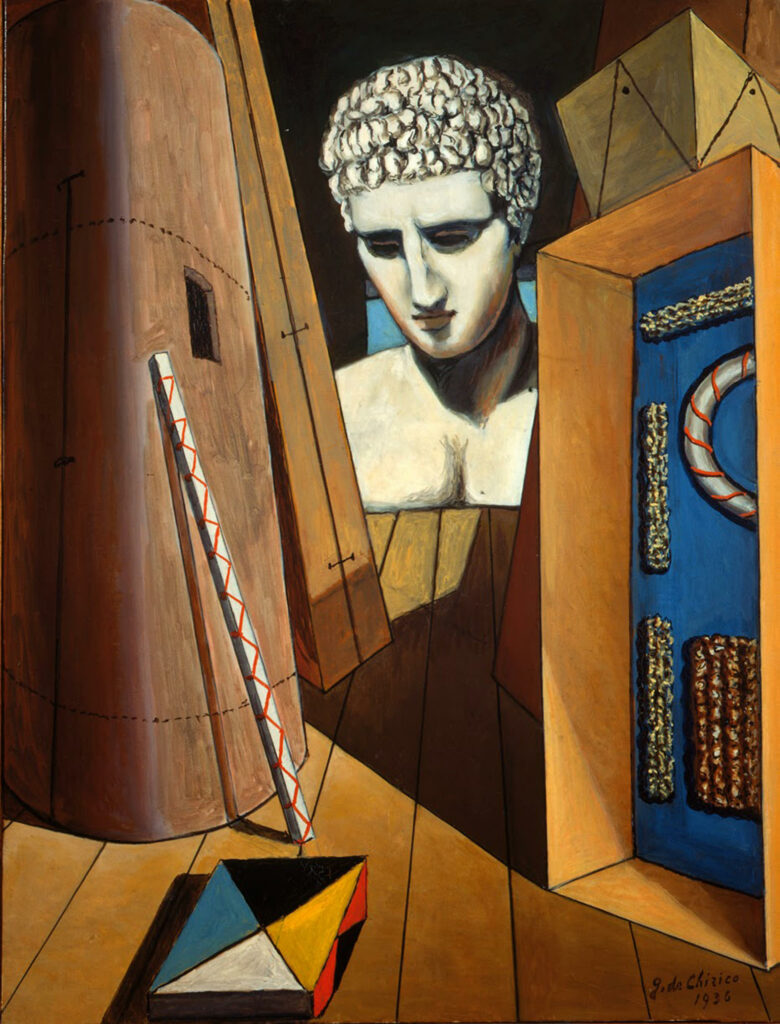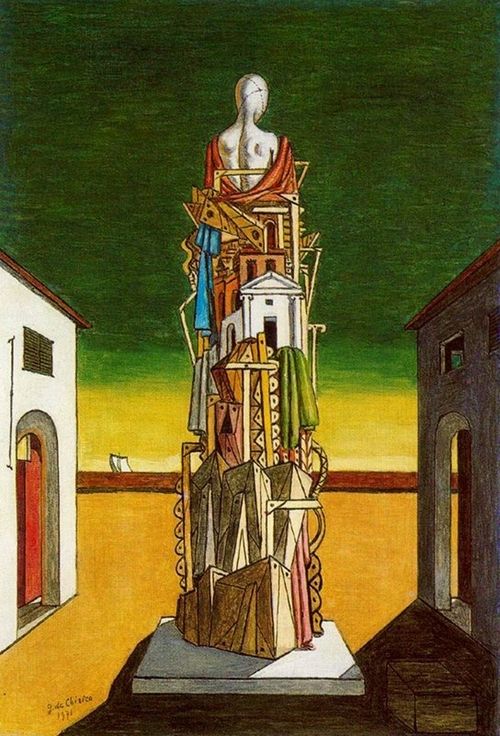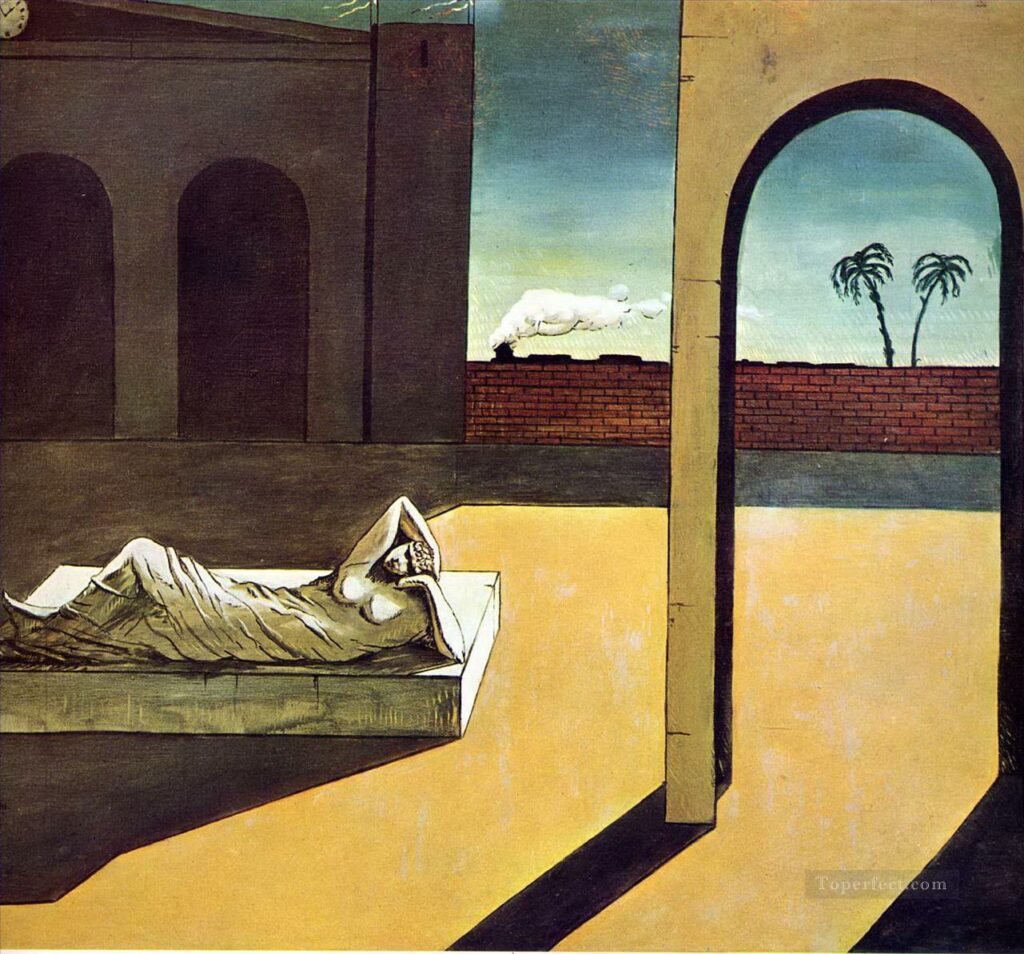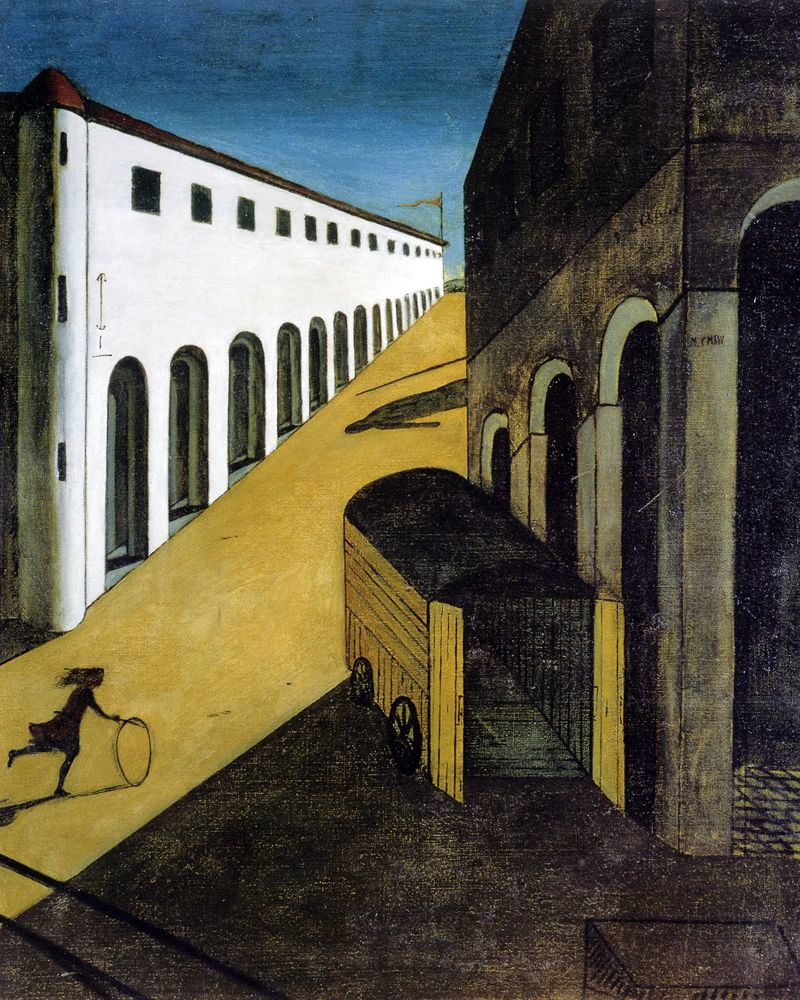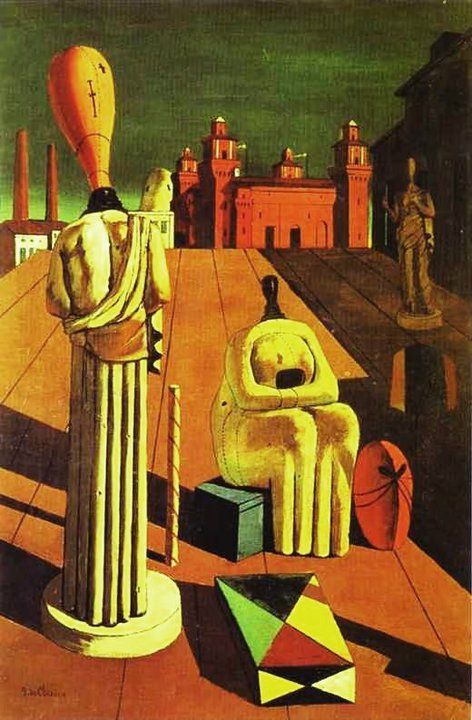Proto-Surrealist Giorgio de Chiroco – about whom there is great exhibition at the Kunsthalle in Hamburg at the moment – and his approach to art has been the focal point and impetus for these investigations into the essence and the spirit, the ideal of art. He demanded (with reference to Schopenhauer and Nietzsche) that art had to become an exploration into metaphysics. What metaphysics is supposed to mean and to be is not entirely clear. Yet, even less than that, and to the misfortune for those who think they can deride metaphysics, it is elusive or confused. Metaphysics means to explore the hidden meaning and essence of things and to enable a meta-rational understanding, i.e. an understanding that is not purely rational, even less irrational, but that establishes a meta-level and perspective upon purely rational understanding, and the a/irr/rational fabric of the world, of existence. It is a transcendent undertaking. De Chirico demands that objects and the entire banal fabric of existence needs to be considered as a mystery, as an enigma in the first place. The introspective exploration of these enigmas is then what may unfold as true art. A truly introspective and profound piece of art, he notes, is created from the most profound depths of the artist and his existence, „where no birds sing, no streamlet rushes“, etc.; where nature and the object world disappear from view and „the dimensions, the straight lines, the forms of eternity and infinity“ emerge; both as a metaphysical abstraction upon approachable reality as well as an imagnative space where visionary realizations of such metaphysical abstractions upon approachable reality can happen.
Giorgio de Chirico´s metaphysical paintings, his visionary realizations of the metaphysical realm „behind“ apparent reality, respectively of the meta-rational metaphysical abstraction upon apparent reality, depict seemingly random or irrational juxtapositions of things: ancient or outdated architectures combined with more contemporary ones, including industry, dummies becoming human or humans becoming dummy-like, therein mirroring each other, playful children becoming identical with their own shadows, sympathetic encounters among humans seen from a more distant viewpoint, rushing steam trains at the horizon of a scenery that seems mostly static and atemporal. Strange illusion! It is a bit uncanny, but not too much. It is an irritating landscape, but an explorable one. It is static, but also vibrant and dynamic. It is dream-like; also seemingly in that respect that most of our dreams are somehow unpleasant, yet the unpleasantness then dissolves into transcience and irrelevance. What an inviting and uninviting world! Says de Chirico, „metaphysics“ to him is „nothing gloomy“, it is rather „tranqulity“ and the „meaningless beauty of matter“, presented in a clear-cut fashion – therein overcoming the weirdness and confusion of the everyday perspective upon reality. It is erect. It is about phantasmal evocation of objects that are wrongly „derided by universal stupidity as petty and irrelevant“. In the metaphysical paintings of Giorgio de Chirico, those banal everyday objects confront the viewer, and the inhabitants of the metaphysical scenery, with their own silent presence and solidity, their individuality. Their own mysteriousness. The bloated philistine mind will deride such undertakings to investigate the „mystery“ of everyday objects. In its vanity, it will think that it already understands the everyday objects. For the philistine mind, there is nothing to explore. Therefore, it is actually pretty unknowing. The metaphysicist, by contrast, will put himself into a position of childlike stupidity, in order to gain higher knowledge and penetration.
This silent presence of objects, of architectures refers to metaphysics actually, and primarily, wondering about presence. Why is there something, and not just nothing? may be the initial question of metaphysics. In these metaphysical visions, those forlorn objects and architectures, seemingly ripped off a meaningful context, confront you with sheer presence. Sheer presence is something sublime. It also is something that is tangible and approachable, even something you can love and can get into deep contact to. Eyeless, this stuff nevertheless seems to look out into the world, in its own confirmation, and looking for its own confirmation. Presence, existence, may then, immediately, make man question for essence, for the meaning and interrelatedness of these objects, and for how man can manipulate them. That is the human intellect that illuminates this world. The sheer presence of objects, and the experience of objects in their sheer presence, is highly evocative. Within this evocation, you experience there is connection between things, an atmosphere in this world, a proto-state of meaning. The seemingly random juxtaposition of things and situatedness of (real or pseudo) persons in the metaphysical paintings of de Chirico refers to that there is context between things, and that entities, of course, can only appear within context. The context is enigmatic. It needs to be discovered, it needs to be manipulated and rearranged, in order to make more sense, to create a world that is more inhabitable, that is more overloaded with meaning, that finally makes sense. It is an ongoing process. The metaphysical world de Chirico depicts may be a world in dissolution and disarray as well as a world of coexistence, even communion, finally a highly sentient, animistic world of togetherness. Coexistence, as seems to be the call, needs to become communion. To explain and to construct within such a world is, then, a matter of physics and of technology, as well as of ethics. Therein, metaphysics is not someting that is „behind“ or „above“ physics, but grasping the primordial. Grasping the primordial will make you feel good, and pure. It is mankind´s return to innocence.
A metaphysical vision, a metaphysical abstraction, necessarily means „seeing it all“ and from a viewpoint of atemporality, or eternity. In a way, it´s a static, stasis-like scenery, where there nevertheless is some tension, vibration and fluctuation. Despite their tranqulity, Giorgio de Chirico´s metaphysical landscapes are full of tension and vibration. This is so because the world is both static and dynamic. Metaphysics strives for a gnosis into universal and eternal truths, but universality and truth evolve within time, and disappear within time. Stuff may appear and then vanish soon thereafter, like within the quantum foam. This vibration is, eventually, reality, and the situation of man within reality. In de Chirico´s paintings and metaphysical vision you have a recurrent range of themes (like dummies, trains, antique statues). Therein, it´s private. Yet, as metaphysics means: a transcendent exploration of objective reality by the subject; respectively a questioning of what objective reality means for the subject, and vice versa; any metaphysical undertaking is necessarily both objective and subjective. It is universal and it is private. Despite allegations, Giorgio de Chirico´s metaphysical landscapes are not a hermetically closed world; they are not claustrophobic visions; you obviously have room for maneuver and you may walk behind the corners of the buildings or behind the walls that stand erect: but what are you likely to encounter there? Either a complete desert or, most likely, more of the same. In a way, de Chirico´s landscapes are prison-like and uncanny. But this is so because existence is prison-like and uncanny in itself. You do not enjoy vast freedoms in this world, that is quite a limited world by itself. This world is not a wonderland. You may strive for a higher, metaphysical consciousness in order to get out of here, but no wonder, the metaphysical representation of a prison-like world will be prison-like again.
I have been interested, obsessed, by obtaining a metaphysical perspective upon things as well. This is, obviously, the high point of art. A vision upon humanity and existence from the viewpoint of a metaphysical abstraction upon humanity and existence you obviously have in the literature of Kafka and Beckett. They would come to mind. In general, profound art is about revealing hidden meaning and essence of things, and coming up with revelations that both come as a shock and a surprise as well as something completely intuitive and logical. This is so because metaphysics – trying to reach that hidden meaning and essence of things – is an associative/dissociative process that nevertheless happens within a highly sober and rational mind. De Chirico and his metaphysical approach – and his writings about his metaphysical approach are no less, if not even more relevant, astonishing and profound than his paintings – has served me well in trying to get to the essence of what art, over all course of time, should actually mean to be. It is impossible that more people on this Earth can paint like this, expects de Chirico, although at his time, and in the subsequent decades, there have been quite a lot of artists that could. The slump in significance in contemporary art seems to go along with having forgotten about such metaphysical attempts and endeavours. No one in contemporary art talks about wanting to strive for the metaphysical. Art now seems much more about a social commentary than about purification of the mind. This is good, since neglect about the social realm has been a true weakness of art in former days. Yet, a commentary is nothing that is avant-gardist. It may have become difficult, if not impossible for art to be avant-gardist, given the massive shifts within society in the last half of a century, and within art in the, say, two centuries before. But I would advocate taking the approach and the example of Giorgio de Chirico more seriously again within art. Actually everyone is unhappy with present-day art, but no one knows what to do. De Chirico can show the way out. Art should be a breakthrough; art is about achievement. Reaching the metaphysical, the noumenal sphere, is the ultimate achievement, the ultimate breaktrough. It is a transcendent breaktrough, it is the transcendent achievement.
As has been noted, the metaphysical representation of a prison-like world will be prison-like again. If you´re imprisoned, you would most likely want to get out of it. Or at least, enjoy more comfort. So how do you get out of the world-prison? The metaphysical endeavour actually shows a good way. For instance, de Chirico´s paintings show the world in an elevated and lofty way, but also in a primordial way. This means: authentic contact and primordial creation is ultimately at hand. Essence and deeper meaning/truth is tangible, sympathy, encounter and contact is possible, it is a space left to wonder and to explore; despite all its limitations, it is, above all, evocative. You are situated, as a metaphysical individual, in both an ancient (and wise) as well as in a primordial and innocent state; you regain the Paradise Lost of childhood. As a metaphysicist, you´re natural; therefore you rise above this world, which is frequently bemoaned as artificial. You have, from the viewpoint of metaphysical abstraction, insight into God´s plan. That is likely a frightening and depressing insight, but, above all, you have insight into God´s plan, and this means you gain freedom hitherto unexperienced, you anticipate the mind of God, you rule the noumenal sphere. Despite being depressed and melancholic, Kafka and Beckett were highly approachable and authentic individuals. They never did something stupid. They were in control. (At least on the sane side of their personalities) they were internally free. In those respects, they were free from the world-prison, they were operating outside the world-prison. That is an elevated state. Their metaphysical visions, and the metaphysical visions of de Chirico, seem god-forsaken. But they become god-like themselves. No one says that God is happy. Melancholy is a frequent theme in the works of Giorgio de Chirico; metaphysics is melancholic and seems to reconfirm melancholia, God is likely the most melancholic mind of all. Melancholy, as already stated by the ancient Greeks, is fundamental for the more profound and explorative mind. Melancholy is a higher passion, or may open the gate to higher passions. Melancholy may provide you with the means of establishing more profound contact. If the metaphysical landscapes of Kafka, Beckett and de Chirico seem god-forsaken and south of heaven, they also indicate what heaven is about. Heaven is about good contact and communion between entities. Heaven is a realm where good contact and encounter is prevalent, it is a realm where there is true and everlasting communion between individual entities, under the sway of Christ, the universal enabler of communion. It is much less drab than the metaphysical landscape as envisaged in the paintings of Giorgio de Chirico which are metaphysical abstractions over physical reality. With the metaphysical spirit, and the respective empathy, higher realms become tangible. They will multiply our melancholy. And then transform it into an eternal bliss.
19.+21.2.2021

